|
|
| |
 |
| |
Six of the 17 penguin species of the world nest in New Zealand, the most diverse population. Four of New Zealand's species are endemic. A group of yellow-eyed penguin, the world's rarest, coming ashore on a surf beach, and walking through forested trails is indeed an unexpected sight. Penguin
once inhabited much of the New Zealand mainland coast, but three species remain in a few isolated locations, since the loss of shaded forest nesting habitat. Four species are on five subantarctic islands. |
Yellow-eyed penguin (Hoiho)
Megadyptes antipodes
The yellow-eyed penguin is one of the rarest, and the fourth largest of the world's penguins. It is endemic and the most endangered of the six New Zealand species, with the smallest population of about 2000 pairs. It is one of three New Zealand species that is still found on the mainland, but it is limited to about 500 pairs on the southeastern coast of the South Island. There are also 150 pairs on Stewart Island and its surrounding islands, but most of the population are on the subantarctic Auckland and Campbell Islands.
|
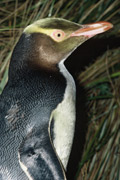 |
The Snares crested penguin, also known as the Snares Island penguin, is endemic to the island group, which has a total area of 341 ha, and is part of the New Zealand Subantarctic World Heritage Site. Snares penguins nest in small colonies ranging from 10 to 1200 nests under the tree daisy forest on the coast of the main North East Island, and in the open on Broughton Island. In 2000, 25,861 breediing pairs were counted on North East Island, and it was estimated there were 4000 pairs on Broughton Island.  See more See more |
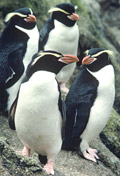 |
The erect crested penguin is endemic to three New Zealand subantarctic islands. The principal breeding colonies are on rock covered Bounty Island and scrub covered Antipodes Island, and a few breed on the Auckland Islands. The erect crested penguin nests in large colonies on rock ledges on the coastline, and is renowned for climbing very steep cliff faces. It is one of the largest crested penguins, weighing up to 4 kg, and standing 50 cm tall.  See more See more |
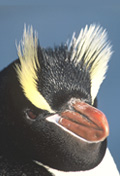 |
The breeding range of about 3000 pairs of Fiordland crested penguin includes the rough Fiordland coast, islands in the Foveaux Strait, and Stewart Island. It is endemic, and one of only three species that breed on the mainland. Codfish Island off Stewart Island is co-inhabited by all three mainland penguins, the Fiordland crested, yellow-eyed, and Southern little blue. Sub-fossil remains indicate that the Fiordland crested penguin was distributed around the South Island, and possibly the North Island.  See more See more |
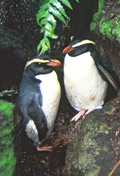 |
Eastern rockhopper penguin
Eudyptes chrysocome filholi
The rockhopper penguin is one six crested penguin species in the world, and one of the smallest at 40 cm tall and weighing 4kg. The New Zealand subspecies breeds on Antipodes, Auckland and Campbell Islands. As its name suggests, it is adept at moving around rocky coastline, and like the erect-crested penguin climbs steep cliffs. Rockhoppers sometimes nest alongside erect-crested penguins on Antipodes Island, a co-habitation trend that also occurs between the Antipodes Island parakeet and Reischek's parakeet. |
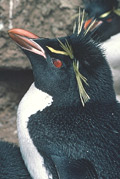 |
In 2011, paleontologists reconstructed from fossilised bones, the skeleton of an extinct giant Kairuku penguin. The prehistoric penguins from the Eocene-Oligocene 24 million years ago are only known from New Zealand, and are one of the largest known penguin species. They stood 1.3 metres tall, and weighed at least 60 kilograms. Kairuku were 30cm taller, and 50 percent heavier than the Emperor penguin Aptenodytes forsteri of Antarctica, the largest living penguin species.  See more See more |
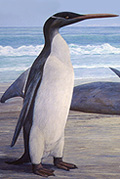 |
Southern little blue penguin
Eudyptula minor minor
The little blue penguin is the world's smallest penguin, 25 cm tall and weighing a little more than a kilogram. The Southern subspecies nests in South Westland, Southland, Stewart Island and the Otago Peninsula. Genetic research of Otago specimens in 2002 shows a relationship between E. m. minor and E. m. novaehollandiae from Australia, that is closer than any other New Zealand subspecies. This divergence occurred 1.4 to 2.5 million years ago.
 Hear the call of blue penguin Hear the call of blue penguin
(needs RealPlayer to run)
 INSTALL REALPLAYER INSTALL REALPLAYER |
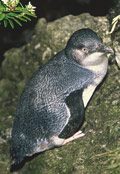
|
Northern little blue penguin
Eudyptula minor iredalei, E. minor variabilis
Chatham little blue penguin E. m. chathamensis
Once very prevalent around New Zealand's coasts, little blue penguin mainland populations have been devastated by rat and stoat predation, but it remains the most common penguin in a limited number of locations. E. minor iredalei nests on northern east coasts of the North Island, and E. minor variabilis is restricted to southern North Island and Cook Strait locations. E. minor chathamensis is endemic to the Chatham Islands. |
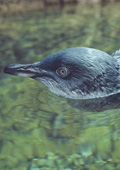 |
White-flippered penguin
Eudyptula minor albosignata
The white-flippered penguin was first described as a separate species in 1874, but was reclassified as one the 6 subspecies of E. minor in 1976. Genetic research in 2002 shows that the white-flippered penguin is more closely related to the Northern and Chatham subspecies. It is endemic to the Banks Peninsula and Motunau Island in the Canterbury region, with only about 3,750 pairs remaining. The white-flippered penguin is barely distinguishable from the other subspecies, but can be recognised by its slightly larger size, lighter color, and a broader white band on the front of its flipper. |
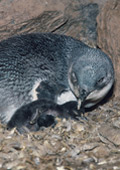 |
Narrow-flippered penguin
Palaeeudyptes antarcticus (Extinct)
The extinct narrow-flippered penguin, together with another fossil species Palaeeudyptes marplesi, is the world's largest known penguin species. It is estimated from a fossil to have stood between 110 and 140 cm tall which is bigger than the largest living penguin, the Emperor Aptenodytes forsteri. It is the last known Palaeeudyptes species. P. antarcticus may have evolved from P. marplesi or the two may have been the same species, with P. antarcticus evolving to a smaller size. P. antarcticus was the first fossil penguin known to science, described from a single, partially damaged, tarsometatarsus found in Late Oligocene Otekaike limestone from 23-28 million years ago, at Kakanui south of Omaru on the east coast of the South Island. Other bones have been recovered from the Late Eocene (34-37 mya) on Seymour Island, Antarctica, but it has not been completely determined by current scientific methods whether the bones belong to a single species.
|
|
| |

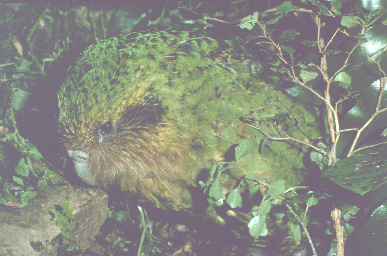 |
2006 IUCN Red List of
Threatened Species
Yellow-eyed penguin
Megadyptes antipodes
Endangered
Erect-crested penguin
Eudyptes sclateri
Endangered
Fiordland crested penguin
Eudyptes pachyrhynchus
Vulnerable
Rockhopper penguin
Eudyptes chrysocome
Vulnerable
Snares Island penguin
(Snares crested penguin)
Eudyptes robustus
Vulnerable
2005 New Zealand Threat Classification System
Erect-crested penguin
Eudyptes sclateri
[2] Nationally endangered
Fiordland crested penguin
Eudyptes pachyrhynchus
[2] Nationally endangered
Eastern rockhopper penguin
Eudyptes chrysocome filholi
[2] Nationally endangered
Yellow-eyed penguin
Megadyptes antipodes
[3] Nationally vulnerable
White-flippered penguin
Eudyptula minor albosignata
[3] Nationally vulnerable
Northern little blue penguin
Eudyptula minor iredalei
[5] Gradual decline
Southern little blue penguin
Eudyptula minor minor
[5] Gradual decline
Snares crested penguin
(Snares Island penguin)
Eudyptes robustus
[7] Range restricted
Chatham little blue penguin
Eudyptula minor chathamensis
[7] Range restricted
Extinct Pre-Pliocene penguins of New Zealand
Aptenodytes ridgeni
Ridgen's penguin
Archaeospheniscus lopdelli
Lopdell's penguin
Archaeospheniscus lowei
Lowe's penguin
Anthropornis nordenskjoeldi
Giant penguin
Duntroonornis parvus
Duntroon penguin
Korora oliveri
Oliver's penguin
Marplesornis novaezealandiae
Harris' penguin
Pachydyptes ponderosus
New Zealand giant penguin
Palaeeudyptes antarcticus
Narrow flippered penguin
Palaeeudyptes marplesi
Marples' penguin
Platydyptes amiesi
Amies' penguin
Platydyptes novaezealandiae
Wide-flippered penguin
Pygoscelis tyreei
Tyree's penguin
Tereingaornis moisleyi
Moisley's penguin
Waimanu manneringi
Waimanu penguin
Waimanu tuatahi
Waimanu penguin |
| |
 |
| |
Photo credit
Top left, center 8th down; White-flippered penguin, Peter Reese
Top 2nd right, center top;Yellow-eyed penguin, Rod Morris
Top 3rd right, center 2nd down; Snares crested penguin, Rod Morris
Top 4th right, center 3rd down; Erect-crested penguin, Tui De Roy
Top 5th right, center 4th down; Fiordland crested penguin
Tui De Roy
Top 6th right;
Eastern rockhopper penguin
Center 5th down; Eastern rockhopper penguin, J.L. Kendrick
Top 7th right, center 6th down; Southern little blue penguin,
Rosalind Cole
Top 8th right, center 7th down; Northern little blue penguin
Rod Morris. All images Crown Copyright © Department of Conservation |
| |
 |
| |
 |
|



















